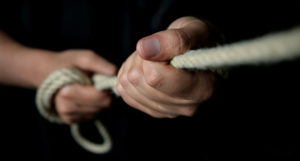19 June 2015
The Council of Europe Trafficking Convention: Magna Carta of rights of trafficked persons.
By Klara Skrivankova, Europe Programme and Advocacy Co-ordinator

On Tuesday the 10th anniversary of the Council of Europe Trafficking Convention was marked in Strasbourg. I was honoured to speak at the event and reflect on the impact of the Convention in the past decade.
The Convention is truly the Magna Carta of the rights of trafficked persons. It was the first and remains the only international law to consider human trafficking primarily as a human rights issue.
Of course the treaty is not without flaws – there is no such thing as a perfect law. But often, it is not the minute detail of legislation what is most important, but the overall impact that the passage of that law has.
With the introduction of the Convention we got an instrument that guaranteed minimum standards of protection to victims and required governments to work with the civil society to tackle trafficking. Until the introduction of the Convention, protection for trafficked persons was considered an add-on, a kind of luxury that could be arbitrarily provided or denied, depending on a victim’s usefulness in criminal proceedings.
Thanks to the Convention, in most countries in Europe there are now structures in place to identify and assist victims. They are meant to protect the rights of trafficked persons and give them an opportunity to access justice.
However, that is still not always the case and in spite of the Convention the systems at times are barriers to justice instead of protecting their rights. They subject victims to onerous bureaucratic procedures and often a culture of disbelief. One of the speakers at the anniversary event, Ms Henriette-Akofa Siliadine, the first person affected by modern slavery to successfully bring her case to the European Court of Human Rights, spoke of her fear about not being believed, being called a liar and having only her word against the words of her abuser.
When a system instead of protecting the rights of the victims exacerbates their violations by disbelieving them, detaining them and prosecuting them, the Convention is a significant safeguard that can be used to correct the injustice.
In a recent case, in which a Vietnamese lady was trafficked for cannabis cultivation to Ireland and was prosecuted instead of being identified as a victim, the High Court ruled that the Irish administrative procedures on identification of trafficking were in breach of international obligations. And it was the Convention that Ms Justice O’Malley referred to to justify her judgment, stating:” standards established by the Convention are these that the Irish State has undertaken to apply…”. The case demonstrated that when governments fail victims, the Convention provides a framework on which courts can rely in interpreting what amounts to protection of the rights of victims.
The Convention was also referred to by the UK Supreme Court in its judgment on the Hounga vs Allen case ruling that trafficked people have the right to recover damages from their traffickers irrespective of their immigration status.
Measures to promote and protect the rights of victims are the weakest pillar in most signatory countries. A report by GRETA (a group of experts mandated with the monitoring of the implementation of the Convention by the signatory countries) published a few weeks ago gives a clear record of gaps – 89% of states were urged to improve identification and assistance to child victims; 80% of countries were to improve victim assistance measures and 77% victim identification. These conclusions correspond with the experience of civil society organisations.
A lot has been achieved in anti-trafficking efforts in the past ten years. These achievements are unlikely to have happened without the Convention.
From our side we, along with nine other organisations, founded the Anti-Trafficking Monitoring Group five years ago to monitor the UK’s compliance with the Convention and keep the pressure on the Government to make it a reality.
Yet, there is still a long way to go until we see human rights approach and the spirit of the Convention truly reflected in practice and experiences of majority of trafficked persons throughout Europe. Making this happen is the challenge for all of us for the next decade.